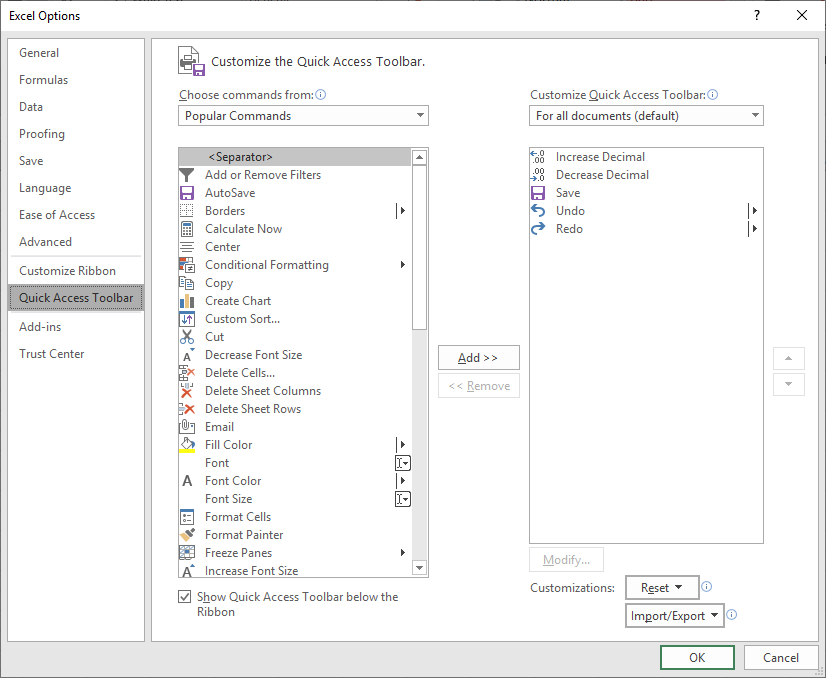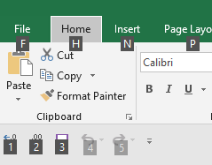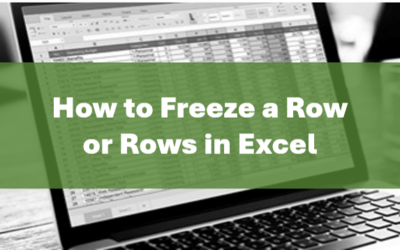Increase or Decrease Decimals Using Your Keyboard
by Avantix Learning Team | Updated April 7, 2021
Applies to: Microsoft® Excel® 2013, 2016, 2019 and 365 (Windows)
Although there are shortcuts to apply number formatting in Microsoft Excel using the Ctrl key, there are not comparable keyboard shortcuts to increase or decrease decimal places for numbers. However, you can press Alt to access the Ribbon or Quick Access Toolbar and then use your keyboard to increase or decrease decimal places.
Recommended article: How to Delete Blank Rows in Excel (5 Ways)
Do you want to learn more about Excel? Check out our virtual classroom or live classroom Excel courses >
Activating keyboard control in the Ribbon
If the Ribbon is not showing, press Ctrl + F1.
Press Alt to activate keyboard control in the Ribbon. Key tips will appear in the Ribbon as a small label or badge. You can also press F10 instead of Alt.
Below is an activated Ribbon after the user has pressed Alt:
Choosing Ribbon commands using the keyboard
To choose commands in the Ribbon using key tips or badge letters:
- Press Alt. Key tips or badges appear on the Ribbon. One layer of badges appear at a time. Once you choose an option (a letter), then a new set of options appear. The key tip badges appear for the active tab.
- Press the appropriate badge letter to activate the desired tab. Do not press Shift.
- Press the appropriate badge letter to choose the command in the active tab.
- Press Escape if you want to exit key tip mode.
Selecting Increase Decimal or Decrease Decimal using the keyboard
To increase or decrease decimals:
- Select a cell or cell range containing numbers.
- Press Alt. Key tips appear in the Ribbon.
- Press H to access the Home tab. Do not press Shift.
- Press 0 (zero) to apply Increase Decimal. Press 9 to apply Decrease Decimal.
Adding Increase Decimal or Decrease Decimal to the Quick Access Toolbar
You may want to display the Quick Access Toolbar below the Ribbon and add buttons to it (it's displayed above the Ribbon by default). To display the Quick Access Toolbar below the Ribbon, click the arrow to the right of the Quick Access Toolbar and select Show Below the Ribbon.
To add Increase Decimal and Decrease Decimal to the Quick Access Toolbar:
- Right-click Increase Decimal on the Home tab in the Ribbon and select Add to Quick Access Toolbar from the drop-down menu.
- Repeat for Decrease Decimal.
- Press Alt and note that numbers appear on the buttons in the Quick Access Toolbar (so if you press Alt and then 1, you would access the first command).
At this point, you may want to move your most frequently-used buttons to the beginning of the Quick Access Toolbar so that Alt and 1 would access the first button, Alt and then 2 would access the second button and so on.
To rearrange buttons in the Quick Access Toolbar:
- Click the arrow to the right of the Quick Access Toolbar and select More Commands. The Options dialog box appears and In the categories on the left, Quick Access Toolbar should be selected.
- On the right, under Customize Quick Access Toolbar, click the button you wish to move and click the up arrow to move the button up. or the down arrow to move the button down. Continue clicking the up or down arrows until the button is in the desired position.
- Repeat for other buttons.
- Click OK.
Below is the Microsoft Excel Options dialog box where you can rearrange buttons:
Note that the Increase Decimal and Decrease Decimal buttons have been placed at the beginning of the Quick Access Toolbar in the following example:
It's definitely a good idea to rearrange the buttons in the Quick Access Toolbar so your most frequently-used buttons appear in the first nine positions.
Subscribe to get more articles like this one
Did you find this article helpful? If you would like to receive new articles, join our email list.
More resources
How to Fill Blank Cells in Excel with a Value from a Cell Above
How to Use Flash Fill in Excel to Clean or Extract Data (Beginner's Guide)
Automatically Sum Rows and Columns Using the Quick Analysis Tool
Related courses
Microsoft Excel: Intermediate / Advanced
Microsoft Excel: Data Analysis with Functions, Dashboards and What-If Analysis Tools
Microsoft Excel: Introduction to Visual Basic for Applications (VBA)
Our instructor-led courses are delivered in virtual classroom format or at our downtown Toronto location at 18 King Street East, Suite 1400, Toronto, Ontario, Canada (some in-person classroom courses may also be delivered at an alternate downtown Toronto location). Contact us at info@avantixlearning.ca if you'd like to arrange custom instructor-led virtual classroom or onsite training on a date that's convenient for you.
Copyright 2024 Avantix® Learning
You may also like
How to Replace Zeros (0) with Blanks in Excel
There are several strategies to replace zero values (0) with blanks in Excel. If you want to replace zero values in cells with blanks, you can use the Replace command or write a formula to return blanks. However, if you simply want to display blanks instead of zeros, you have two formatting options – create a custom number format or a conditional format.
What is Power Query in Excel?
Power Query in Excel is a powerful data transformation tool that allows you to import data from many different sources and then extract, clean, and transform the data. You will then be able to load the data into Excel or Power BI and perform further data analysis. With Power Query (also known as Get & Transform), you can set up a query once and then refresh it when new data is added. Power Query can import and clean millions of rows of data.
How to Freeze Rows in Excel (One or Multiple Rows)
You can freeze one or more rows in an Excel worksheet using the Freeze Panes command. If you freeze rows containing headings, the headings will appear when you scroll down. You can freeze columns as well so when you scroll to the right columns will be frozen.
Microsoft, the Microsoft logo, Microsoft Office and related Microsoft applications and logos are registered trademarks of Microsoft Corporation in Canada, US and other countries. All other trademarks are the property of the registered owners.
Avantix Learning |18 King Street East, Suite 1400, Toronto, Ontario, Canada M5C 1C4 | Contact us at info@avantixlearning.ca










